8
Treatment Success with Implant Overdenture
IMPLANT SURVIVAL
Most studies available on mandibular overdentures report a success rate of 90 to 100 percent. Neither the number of supporting implants nor the type of attachment assembly has been found to affect the rate of survival.
In contrast, the results of implants placed in the edentulous maxilla, particularly in conjunction with overdentures, are less favorable. Multiple studies have shown a higher failure rate for implants placed in the edentulous maxilla. If a distinction between the degree of atrophy in the maxilla and the bone quality is made, the results show that failure in the maxilla is a result of short implants, poor bone quality, and an inadequate number of implants.
Although bone grafting is often recommended for patients with advanced atrophy, this surgical procedure typically results in a high percentage of implant losses and increased bone resorption.
PROSTHETIC SUCCESS
Evaluation of prosthetic success can be challenging, since a clear distinction among normal maintenance, repairs, and adjustment of the prosthesis is not made. Maintenance due to normal wear can become excessive and a biased criteria for assessment of success. Complications can vary widely from requiring a simple adjustment to a remake of the entire prosthesis.
Clinically, the overdenture is simpler, and its initial treatment is less expensive compare to fixed prosthesis. However, since overdenture has more components (abutments, clips, bars, anchors, and female retainers), it carries a higher chance of complication.
A five-year longitudinal study comparing two resilient attachment assemblies showed more complications with bars than with ball attachments. Another study compared rigid and resilient attachment assemblies for mandibular overdentures supported by two implants during 5–15 year periods. This study showed no significant difference between the incidents of complications between the two groups. However, replacement of the entire attachment assembly was more common with stud attachments and round bars than with rigid bars.
PATIENT RELATED FACTORS
Treatment success should not be evaluated only on the implant and prosthesis survival and success. The psychological and physiological impacts of overdenture treatment on a patient’s quality of life should be considered as well. The treatment cost and financial status of the patient are also important factors in deciding a treatment strategy. The average person may accept implant overdentures supported by two or four implants over the fixed prosthesis because they are less expensive.
BIOMECHANICAL RISK FACTORS FOR UPPER IMPLANT OVERDENTURE
- An upper implant overdenture attachment assembly design is an ideal solution that has minimum biomechanical risk. One clip/rider should be used for each bar (Figure 8.1).
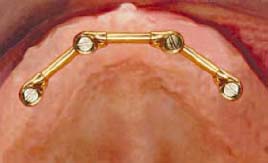
- This design is mechanically less favorable than previous designs since the lateral forces will not distribute among all four implants. However, this design provides a better anterior aesthetic compared to previous designs (Figure 8.2).
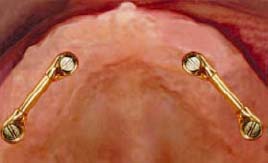
- This design has a higher biomechanical risk compare to the previous two designs. This design is a completely non-resilient attachment assembly with cantilever components. It is very important to consider the Anterior–Posterior spread in this design. Generally, the distal cantilever should not exceed half of the Anterior–Posterior spread (Figure 8.3).
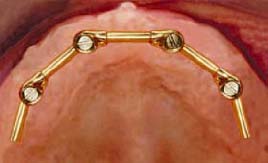
- This design represents a moderate biomechanical risk when the supporting implants are not parallel (Figure 8.4).
- This design creates a high biomechanical risk, especially if the palatal coverage has been eliminated and the flanges are reduced. This design should only be used with an upper complete denture and maximum tissue coverage in cases in which the patient has severe bone loss, but there is still enough bone quantity to place two implants in the canine areas. If the patient is willing to consider a bone graft procedure, then this treatment option should be avoided (Figure 8.5).
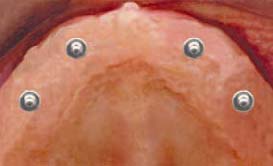
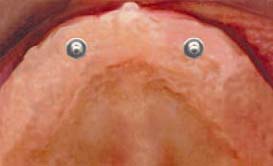
From experimental points of view, maxillary overdentures are best supported by multiple implants connected by a rigid bar and reinforced with a metal framework to enhance rigidity of the superstructure.
BIOMECHANICAL RISK FACTORS FOR LOWER IMPLANT OVERDENTURE
- The lower implant overdenture is an ideal design in regard to biomechanical aspects. The bar should provide at lease hinge resiliency for the prosthesis. More resilient bars will provide more load relief on the supporting implants (Figure 8.6).
- This design is very simple and practical and will provide significant biomechanical advantages to the supporting implants. A more resilient stud attachment provides more load relief for the implants (Figure 8.7).
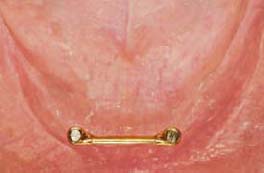
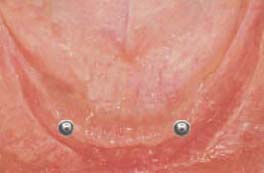
- This design represents a significant biomechanical risk to the supporting implants. It carries a high risk of fracture and bending mode of failure for the cantilever distal extensions (Figure 8.8).
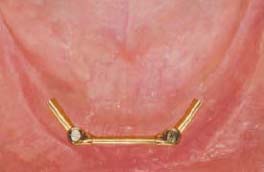
- This design provides less biomechanical risk compared to previous designs. However, it is very important to design the distal extension cantilevers based on the Anterior–Posterior spread measurement (Figure 8.9).
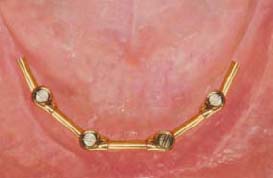
- This design presents a significant biomechanical risk when the implants are short, narrow, and do not have enhanced surface characteristics. With this design, the attachment assembly does not provide any resiliency for the prosthesis or load relief to the supporting implants. The prosthesis is fully implant borne and not enough implants are available to support a fully implant-borne prosthesis (Figure 8.10).
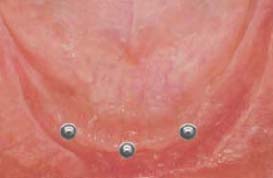
- The attachment assembly in this design is rigid non-resilient. This assemb/>
Stay updated, free dental videos. Join our Telegram channel

VIDEdental - Online dental courses


